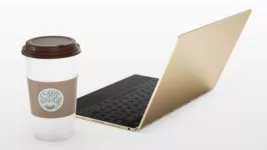Tablets are selling well at the moment which is sparking a bit of a race to find a configuration that people will get excited about. Apple put the iPad on growth hormones to create the iPad Pro but given the iPad is basically a huge iPod touch I actually think making it bigger wasn’t the way to go. Of course this was in response to the Microsoft Surface tablet which has been selling particularly well, largely because it is a great notebook replacement. But notebooks with removable keyboards have historically not done that well largely because most folks always need the keyboard but just taking a tablet and turning it into a notebook hasn’t worked out well either, those have been called Netbooks or Chromebooks and, outside of education where kids don’t get a choice, the idea of having a crippled notebook even at aggressive prices hasn’t been a good one.
The Lenovo Yoga Book is a very different spin on this. It is a clamshell design but with a very unique keyboard one designed to highlight what a tablet can do, keeping the mechanical parts to a minimum, and still being design forward like the iPad is.
Let’s talk about the Yoga Book this week.
Windows or Android
One interesting aspect of this is you get a choice of operating systems. Windows which allows the product to go after the same kind of business focused opportunity that Microsoft’s Surface goes after, and Android, which is better positioned against iOS than Chrome is because of stronger application support. The ideal solution of course would be something that could run applications from both but this at least gives the buyer a rare choice between two focused configurations, one tablet centric and one laptop centric.
Digitizer
What really makes the Yoga Book stand out, however, is the digitizer keyboard. This allows a level of drawing resolution the iPad can’t match and the artist’s hand doesn’t obscure the image which should lead to fewer errors and faster creation. In theory this is actually, on paper, an improvement over what can be done with physical media like pens, brushes, paper, or canvas. It gives this product a unique primary target audience with those who draw for a living. This also supplies a touch keyboard. A decade ago you couldn’t give a touch keyboard away, but, after a decade of touch screens and the issues with fingerprints and inaccuracy when you have to share the screen with the keyboard, this improvement should be well received. In effect folks are now used to the keys not moving but would still prefer not touching the screen and this does that.
Appearance
This thing is beautiful and tablets historically have been as much about status as they are about getting anything done. The Yoga Book looks, as you can tell from the picture, almost jewel like and is arguably the most attractive tablet in this semi-business class. Status has traditionally driven this latest tablet wave and having product with a hinge and overall design that is, frankly, stunning should provide additional interest in the offering. It is one of the most beautiful products I’ve ever seen.
Backstory
What I think is interesting is this isn’t the first attempt to do a product like this. IBM, which sold their PC division to Lenovo had a product called the Transnote which was similar in concept. But the technology just wasn’t ready back then. Then Microsoft had an internal product called the Currier Tablet which was promoted by their skunk works division, it was killed for political reasons despite the fact it was very well received once leaked. The Yoga book pulls from both designs and perhaps will showcase that the Currier Tablet might have actually been a hit earlier than Surface could be.
Wrapping Up: Innovation
It kind of funny that this market screams for innovation and, often, when it gets it gets upset that innovation brings changes. It seems to want innovation but only if there really is no innovation. Having said that, the Yoga Book is arguably one of the most innovative and beautiful tablet products yet to hit the market. In its Android form it is a strong alternative to the iOS based iPad Book and in its Windows form a strong alternative to the Surface tablet. You know, when it comes to retention, writing works better than typing for notes and this is the tablet for folks that like to write and draw.
It’s kind of fun to see a firm step out like this and create something and given this one starts at a very reasonable $499 and is available already this isn’t a bad experiment, not bad at all.








